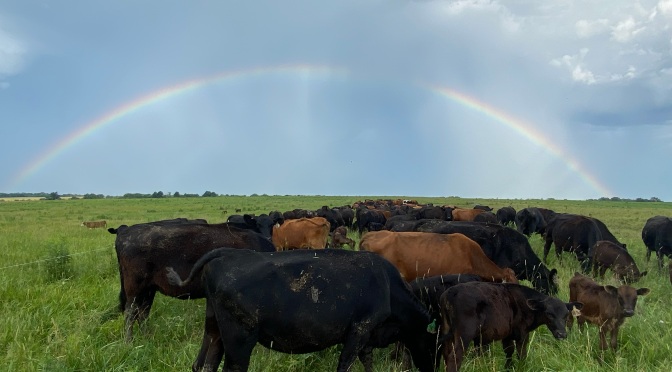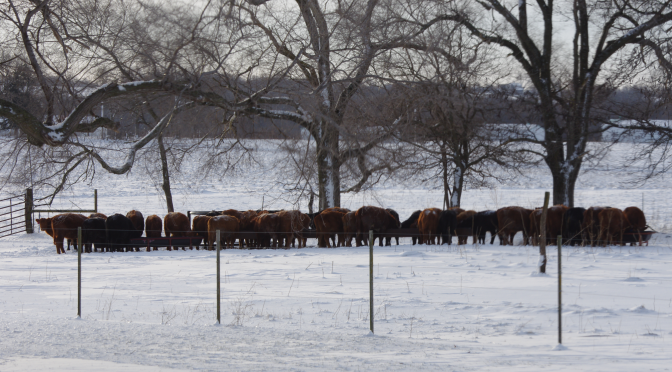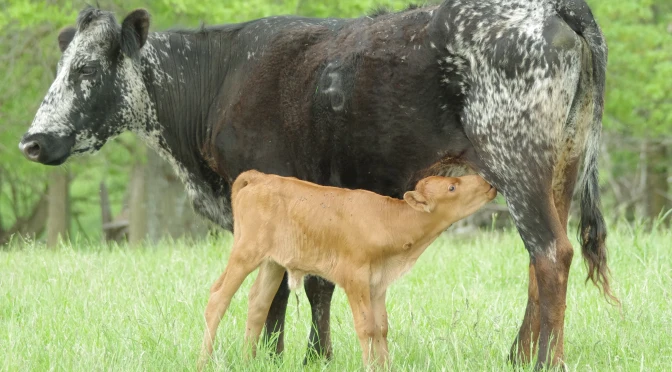Having just returned from a 3-week sojourn visiting friends through Oklahoma, Texas, and Kansas, there is very serious and visible evidence of continued drought in those areas. Fire danger is pegged at super high. Without rain soon, pastures will struggle to start their normal growth. Whatever ‘normal’ is anymore.
As the short, cold, blustery, gloomy days of winter slowly lengthen towards spring with renewed growth and opportunity, it’s a good time to review the past year(s) and plan to overcome mistakes and explore new pathways towards better land stewardship, animal husbandry, and profitability. Creating harmony is a good goal, so finding ways to accomplish that will mean different paths to each person and will include others and the season of our lives.
For this moment, I want to consider the very real possibility of severe drought and have a plan in place before it might arrive. How can my ranch harmonize profitability, animal welfare, and land improvement if drought becomes a reality.
In our area of north central Missouri, the ‘normal’ time to begin stockpiling forages for winter grazing is about August 10. However, for the past 5 consecutive years, those late summer/early fall rains have been nonexistent. This is entirely why I sold about 33% of my cow herd in the fall of 2020 because of my grazing protocol for the past 30 years I had no stockpile and was looking at another winter of feeding hay. No more I decided, so I sold any cow that had no calf at side and any pair which was not replacement quality calf regardless of age or condition. Additionally, even though it was hard for me (because I like colorful cows), I sold any cow with ‘chrome’ even if she was a good producer. Colorful calves are heavily docked in price in our area regardless of quality.
That was my ‘drought’ plan for that winter even though we really were not in a period of low rainfall; the rains are just not coming at the time needed. Shortly after that, Jaime Elizondo appeared in my view again, this time via Instagram, so I e-mailed him and asked him what in the world he was talking about! I took his courses and am a monthly subscriber to ongoing education (Fat Wallet Rancher) – game changer! Within weeks, I now realized my managed grazing program was creating my ‘drought.’
Although, even with having found a few head of cows or heifers to increase mob numbers, I’m seriously understocked. However, referring back to my trip and the talk of the experts, it could be that Missouri may experience real drought this year (2022). Time will tell.
The point of sharing these thoughts is perhaps to remind myself of a good way to address the unknown and be prepared. For sure, no one knows if we will have a drought. It is somewhat dry in our area now, but subsoil moisture is good and ponds are full. But if one is uncomfortable going into the season fully stocked, then make changes now if livestock prices are good. And that they are.
- Sell any and ALL cows without a calf – immediately
- Sell any bred cow with or without a calf at side if she doesn’t have a replacement quality calf
- Sell any cow – open or bred – who has missed having a calf at any time in her past
- Sell steers of any weight which are in demand
- Sell heifers of any weight which are in demand and you don’t plan to keep as replacements
- Maybe go through your bull battery and see if there are old bulls that need selling. Be careful here until after semen check to be certain you have enough adapted bulls for your own herd.
- Anything with a flighty or dangerous attitude goes immediately.
- Making sure you are calving in sync with nature will be one of the biggest changes you can make to become more profitable, though it’s not the only easy management change you can implement to address drought situations.
Some of our cows may not be good cows – how do I justify selling them to someone else? Oftentimes, if I have a known poor producer (which thankfully I no longer have – but it takes drastic purging to get to that point), or one which has developed a flighty or dangerous disposition, I speak up at the sale. But most will be fine in a more traditional herd. I push my animals to perform in mob grazing, total grazing, and a very short breeding season.
Bottom line is to ask one’s self – if I can’t make money with this cow or worse, she is costing me money, how can I possibly think that simply having another calf to sell is a good thing? NO! Even if you go through a time of low inventory and not many calves to sell – it is far better to not have the expense of an unproductive ‘factory.’ Sell it into a situation in which she may perform. She is simply not adapted to our farm and management and probably never will be.
Perhaps you will need to find a side gig or off farm job to make up the difference for a few years, but when those replacement heifers and possibly home raised bulls out of the very best cows you have start to build in numbers, you will be SO far ahead of the game. However, that will also affect your cash flow until those heifers start producing. Cow/Calf production is a long-term game. Be prepared.
As far as the possibility of a drought, this also leaves you in a position to be very low on numbers. If you have been diligent and don’t have any of the cows mentioned in the sell list, then it will be harder to part with some. Maybe wean early (sell the cows) and keep their replacement calves – they won’t eat as much – yet you will still be keeping your best adapted genetics. Depending on the cost, one may consider shipping the stock to a place where custom grazing is available.
There are times in some areas with years of extended drought – if those are normal, perhaps livestock is not the right use of the land in that climate. Or maybe just a certain class of livestock will work. However, in north Missouri, droughts are usually short duration and/or are of our own making. I remember my grandpa telling of a time in the 1950s in which they cut down trees to feed the cows, but am thinking that works well but only for short term.
In Missouri on primarily cool season forages, we typically experience a ‘summer slump’ in which heat and humidity and no rains result in little to no growth in forages in the middle of the summer. This is not drought, but an annual event which can be planned for. Utilizing total grazing techniques can prepare you for this slump by having ample forage for grazing until the cool season grasses start growing again when temperatures start cooling in the fall.
What has worked for you in a drought situation?
Shalom!
tauna










